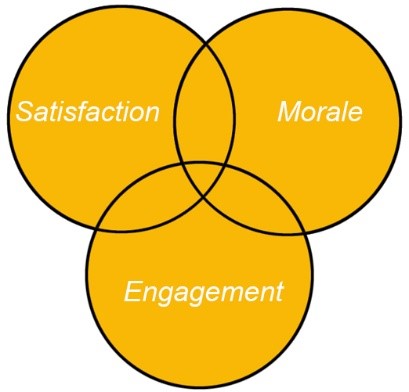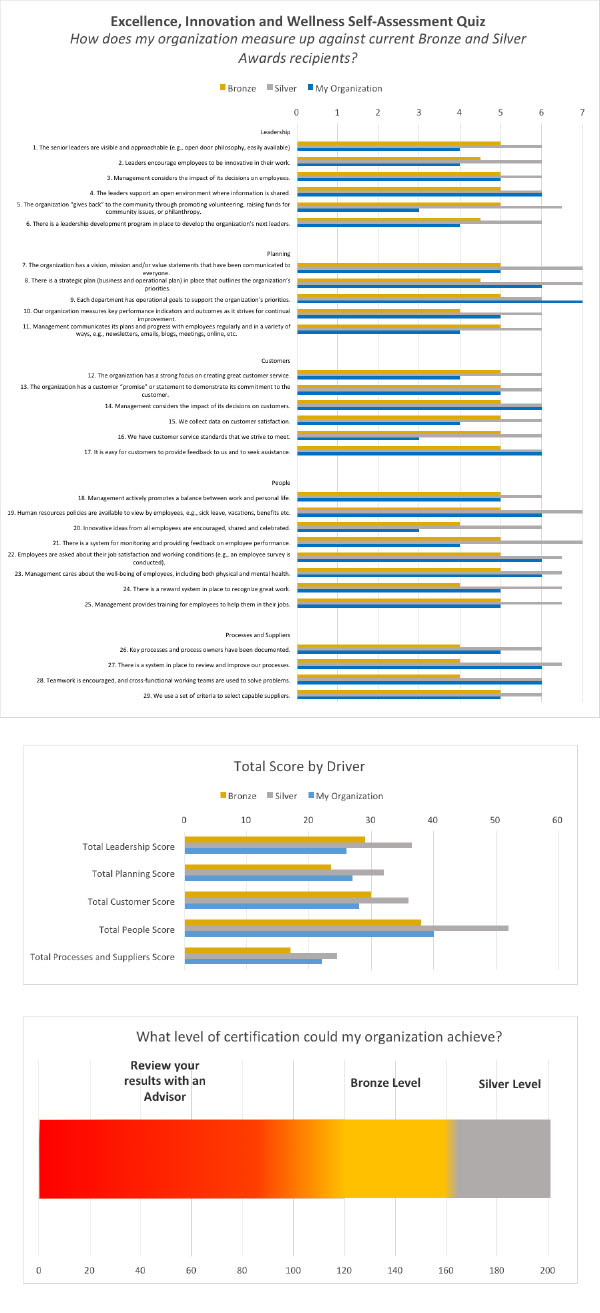Your immediate organizational priorities and needs have changed dramatically during this pandemic. Normal is pretty much out the window. Things like quarantining, self-isolation, and social-distancing have become topics that dominate agendas of our online staff meetings. Worry, fear, uncertainty, and anxiety have come to the forefront of our brains, none of which are good ingredients for healthy “Happiness at Work.” Let’s explore ways to keep ourselves happy at work in these unprecedented times.
The following diagnosis tool assumes that you are not worrying about survival at this point. For families who are legitimately worried about putting food on the table, paying your rent or mortgage and meeting month-end bills for necessities, I wish you the best in finding your way back to greater security as quickly as possible. For the rest of you, try the method below.
Happiness at Work is complex. It’s a feeling that we all share at work, and it’s a mix of three separate measures. Those are the measures of satisfaction, engagement, and morale. In figure 1, happiness at work lives where the three circles overlap.

Figure 1: Happiness Circles
Satisfaction is the baseline. It’s a cognitive measure that highlights how much we ‘like’ being at work. Things like job features, pay, and supervision are important levers to improve satisfaction. Satisfaction is under extra pressure in 2020 because there is uncertainty surrounding basic job features like pay, training, and recognition.
Engagement is a little deeper. It’s an affect measure that is closer to things we ‘love’ at work. The importance and meaning of our work drive engagement. In 2020, engagement is harder than usual because the strategy horizon for most organizations is blurred and fuzzy. The overall aim and mission for most organizations has shifted from purpose to survival.
Morale is a shared measure that emphasizes membership and organizational culture. Morale is the most fragile of the 3 happiness measures. Morale is even more fragile than usual in 2020 because typical collaboration and organizational community have been tested and stretched with social distancing and isolation.
Even in tough times, this mindset has a better chance of survival when all three measures of happiness are being focused on. You’d think it would be easy to focus on these things, but research from a couple years ago showed that only 26% of Canadian employees are happy at work. Eighteen percent are actively grumpy, and the other 56% are generally not happy. In today’s pandemic climate, the number of happy employees would no doubt be even lower. Part of the reason why it’s so difficult for organizations to focus on the point where happiness occurs is that the target (center of the circles) is so small. In good times the target for employers is already very small, and it’s even smaller today.
What can we do to improve Happiness at Work?
Think about the last time you went to the doctor. You tell them your symptoms and they prescribe a course of action or some medication. You follow the recommendation and you’re back to normal in due time. We could look at ‘Happiness at Work’ in the same way.
There are a least 3 problems with ‘Happiness at Work’ that we could treat with strategy.
You could be suffering from
- low satisfaction
- low engagement
- low morale
Of course, you could have a combination of all the above where you need to prioritize based on your assessment of the gaps between where you currently are and where you want to be. Here is a self-assessment tool to diagnose your biggest opportunity for improvement .
Low Satisfaction
Your symptoms include:
Symptom Self-Assessment Score (0-10) 10= very worried, very strained, very low
Worry about your pay
Worry about level of supervision
Strain with the people you work with (direct reports and/or boss)
Worry about vacation days
Worry about lack of training
Low levels of reward and recognition.
Total Score /60
Low Engagement
Your symptoms include:
Symptom Self-Assessment Score (0-10) 10= very uncertain, very low, very little
Uncertainty around aim/mission/vision of the organization
Low levels of meaning of your work (deemed non-essential)
Low levels of commitment to your work
Uncertainty on what you should be spending your time on
Little use of your strongest skills
Low levels of trust for the organization’s future
Total Score /60
Low Morale
Your symptoms include:
Symptom Self-Assessment Score (0-10) 10= very isolated, very lonely, very low
Feeling of isolation
Feeling of loneliness
Low levels of membership
Low levels of sharing
Low levels of group meaning
Low levels of collaboration
Total Score /60
The element of happiness at work with the highest score is the one that you need to work on the most. This leads us to the recommended treatments for organizations.
Treatment for Low Satisfaction as we Fight the Covid-19 Threat
- More focus and communication on HR structure and policies
- Transparency with pay and decisions about compensation
- Revisit reward and recognition approach. Include easy options for praise and demonstrative recognition
- More effort/training on reducing stress
- Explore options for virtual training to increase confidence and skill. Staff working from home could include webinars and online learning options in their daily routines
Treatment for Low Engagement as we Fight the Covid-19 Threat
- Focus and communication of your organizations ongoing aim/mission/vision/goals
- Clear communication on how individual roles contribute to achieving aim/mission/vision/goals
- More strategy work on meaning and sense of purpose
- More effort on identifying individuals’ strengths and assign work that takes advantage of these strengths
- More effort on shared language and consistent approaches
- More opportunities to interact and collaborate with others in a virtual way. Online group training and/or virtual meetings
Treatment for Low Morale as we Fight the Covid-19 Threat
- Increase teamwork and collaboration virtually
- Regular team meetings using technology with cameras to see faces
- Increase efforts on remote team spirit
- Short regular meetings to socialize and update on life in general
- Increase shared experiences and teamwork
- Increase effort on sharing of relevant information
- Ongoing “drop-in” availability of team members in both formal and informal ways
- Continued availability of training for both job skills and leadership development (groups participating together via online learning and webinars)
Those recommended treatments are ready to be implemented. Always remember that we are happier if we focus on the positives of a situation. People tend to focus on, and have meetings about, problems and what is going wrong at work. If you look at a typical week at work and count the hours you were focused on problems, you might be surprised how high a percentage of your time that was. Your reality is shaped by what you focus on, so I suggest you shift your time to strengths and what is going well at work and how we can replicate that. Don’t ignore the opportunities for improvement but give equal weight to the strengths. Our brains become the architect of our reality, and we have the ability to create our own happiness.
I wish you luck on moving towards the centre of the happiness circles and increasing your “Happiness at Work” mindset. Be aware that no one lives in the center of those circles all the time, especially in the current environment. This bump in the road can be smoothed out with some deliberate and conscious strategies/treatments. We’ll look back on this and think that quarantining, self-isolation, and social-distancing didn’t have a chance against the strong spirit of “Happiness at Work”.
Available Webinars:
Employee Happiness – Maximizing Engagement, Satisfaction and Morale
Article written by:
Dr. Adam Stoehr is the Vice president of Research at Excellence Canada. He is one of Excellence Canada’s primary facilitators and speakers. He researches and typically speaks about strategy, employee happiness, organizational excellence, customer experience, leadership, process improvement and all forms of quality management. He has a PhD in Business Strategy from the University of the West of England, Bristol Business School. His published thesis explores the relationship between a strategic approach to quality and employee happiness. He also holds a Master of Business Administration (MBA) from the Rotman School of Management at the University of Toronto. Instagram: @ExcellenceCanada
